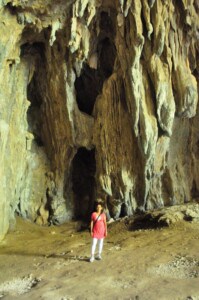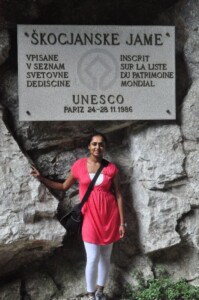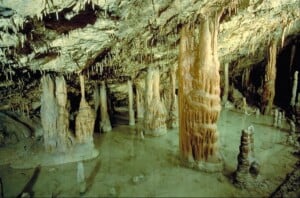
Skocjanske James / Skocjan Caves
Europe

I was in Piran, a small, clean & historic town in Slovenia, at a café located in the centre of the city overlooking the vast ocean enjoying my cup of frothy cappuccino while my friends indulged themselves with the locally brewed beers. During the course of our conversation I learnt about the UNESCO World Heritage site in Slovenia. –Skocjanske James or Skocjan caves. And I immediately made a mental note to visit this place.
For your information Slovenia brews only two brands of beer locally – Lasko and Union (pronounced Oo-nion); while the rest of Europe is a beer lover’s paradise. Belgium, I was told, offers around 600 brands of beer! Now who would think that it might take up to two long years to taste all brands of beer within a single country?!!! Happy thought for most of you isn’t? The very next day morning I set off towards the Skocjan Caves Regional Park which is in the south-west of Slovenia, on the main Krast plateau. It takes roughly about an hour from Koper, a beautiful seaside town just a stones throw away from Italy mainland, to reach the caves. There are regular buses running to and fro to Krast region. There are also trains that ply but not at frequent intervals. One can explore the caves through guided tours only. A guided tour of nearly 2 hours costs 14 Euros per head. The excursion begins with a short walk to the mouth of the cave lead by the guide. Completely a natural phenomenon, Skocjan Caves are of global significance and are ranked side by side with the Grand Canyon, the Great Barrier Reef, the Galapagos Islands, Mount Everest and others. The Skocjan Caves were entered on UNESCO’s list of natural and cultural world heritage sites in 1986.
 The mystical stalagmites, stalactites and various columns line your path as you walk through the 6 km stretch of passage inside this numinous cave. The guided tour included interesting tidbits such as – how one can identify a live stone from the rest – through the white calcite deposits over the rocks! By the way touching any of these stones is strictly prohibited. The magnificent stones kindles your creativity as you start imagining various figures – humans, animals, monsters… et all! No textbook can ever capture the glory of these awe inspiring caves. (There were couple of fellow tourists who were reminded of their mother-in-laws face profile – when we were all asked to let our imaginations take over!!)
The mystical stalagmites, stalactites and various columns line your path as you walk through the 6 km stretch of passage inside this numinous cave. The guided tour included interesting tidbits such as – how one can identify a live stone from the rest – through the white calcite deposits over the rocks! By the way touching any of these stones is strictly prohibited. The magnificent stones kindles your creativity as you start imagining various figures – humans, animals, monsters… et all! No textbook can ever capture the glory of these awe inspiring caves. (There were couple of fellow tourists who were reminded of their mother-in-laws face profile – when we were all asked to let our imaginations take over!!)
 Intriguingly, the Reka River disappears underground at Velika Dolina into the Skocjan Cave (Skocjanske Jame) and then flows underground for 34 km towards the Adriatic Sea surfacing near Monfalcone, in Italy, where it becomes the source of the Timavo River. As you approach this part of the cave sounds of the running water reaches you almost in whispers hence its name “The Whispering Caves”. One time in the past the Reka River swelled up so much that it covered the whole of the cave and none could enter! A board has been put to mark the level of the water during this flood.
The entire walk underground is a mind blowing experience, as we were taken through the various caves. There are huge spaces inside, with the roof top of some of the caves being as high as 100-120ft. Some of these spaces were big enough for a small children’s park inside!! The water drips all over the place and the atmosphere is very cool. The different rock formations have to be seen to be believed and most of the big ones have been named by the guides to make it easily recognizable. As one moves from the new part of the caves to the old part (this is only concerned as per their timelines with their discovery by explorers – not their making by nature!!) one can immediately see the difficulties that early explorers have faced in their adventures. All the caves underground are not opened for public, as lot of restoration work is still going on.
The total number of stairs in here adds upto approximately 600 numbers including the ones that are going up and down. Photography is prohibited throughout the caves except at the exit point. At some points of the long underground walk we were 150 meters under the ground!! A very humbling experience for me, and now, I have been in the water (I walked 30 ft underwater on the seabed in Mauritius) and now under the earth in Slovenia…So now I need to walk in the sky or maybe the space?????
By the way your ticket also entitles you for a visit to the cave museum which entails an illustrated history of the exploration of the Skocjan caves. All in all this walk underground is something which I would recommend to all my friends, if they are visiting Slovenia.
Intriguingly, the Reka River disappears underground at Velika Dolina into the Skocjan Cave (Skocjanske Jame) and then flows underground for 34 km towards the Adriatic Sea surfacing near Monfalcone, in Italy, where it becomes the source of the Timavo River. As you approach this part of the cave sounds of the running water reaches you almost in whispers hence its name “The Whispering Caves”. One time in the past the Reka River swelled up so much that it covered the whole of the cave and none could enter! A board has been put to mark the level of the water during this flood.
The entire walk underground is a mind blowing experience, as we were taken through the various caves. There are huge spaces inside, with the roof top of some of the caves being as high as 100-120ft. Some of these spaces were big enough for a small children’s park inside!! The water drips all over the place and the atmosphere is very cool. The different rock formations have to be seen to be believed and most of the big ones have been named by the guides to make it easily recognizable. As one moves from the new part of the caves to the old part (this is only concerned as per their timelines with their discovery by explorers – not their making by nature!!) one can immediately see the difficulties that early explorers have faced in their adventures. All the caves underground are not opened for public, as lot of restoration work is still going on.
The total number of stairs in here adds upto approximately 600 numbers including the ones that are going up and down. Photography is prohibited throughout the caves except at the exit point. At some points of the long underground walk we were 150 meters under the ground!! A very humbling experience for me, and now, I have been in the water (I walked 30 ft underwater on the seabed in Mauritius) and now under the earth in Slovenia…So now I need to walk in the sky or maybe the space?????
By the way your ticket also entitles you for a visit to the cave museum which entails an illustrated history of the exploration of the Skocjan caves. All in all this walk underground is something which I would recommend to all my friends, if they are visiting Slovenia.